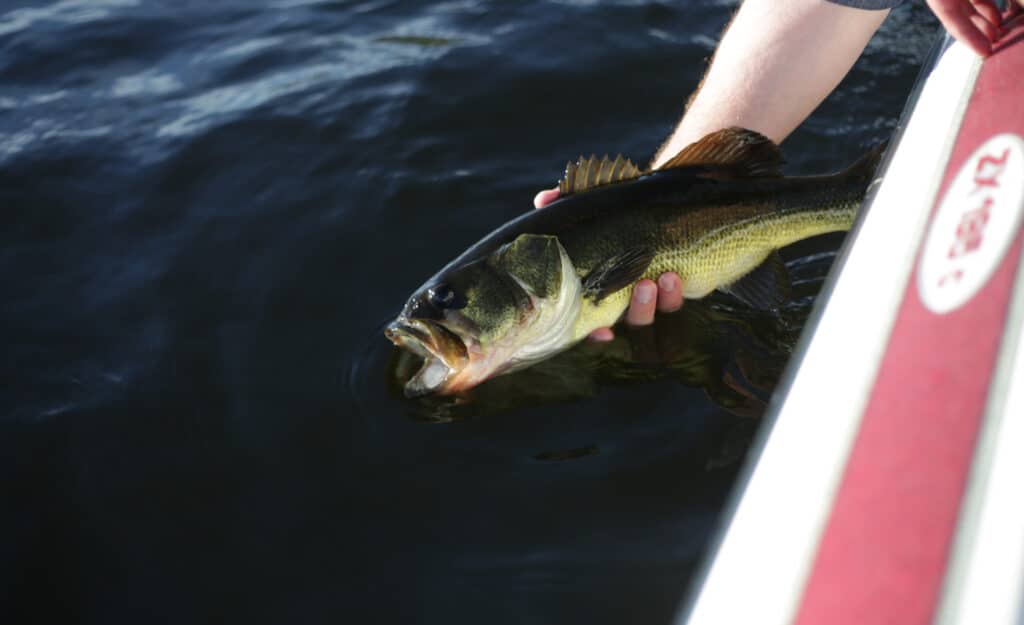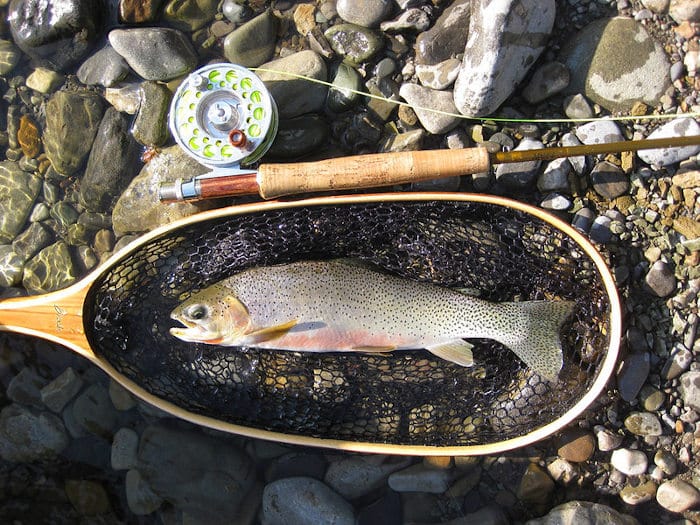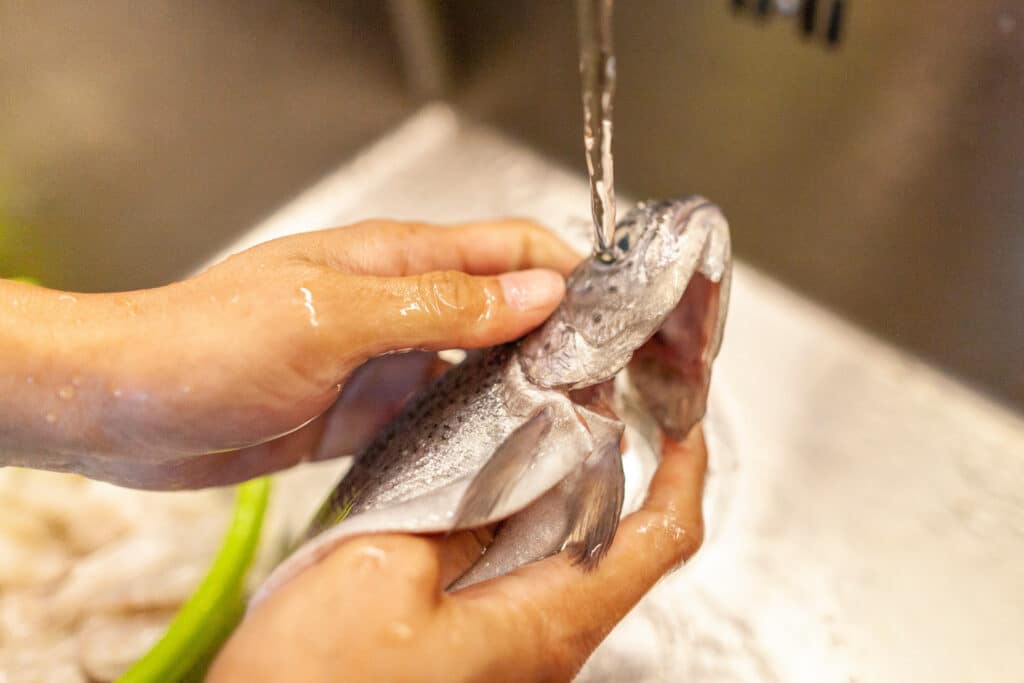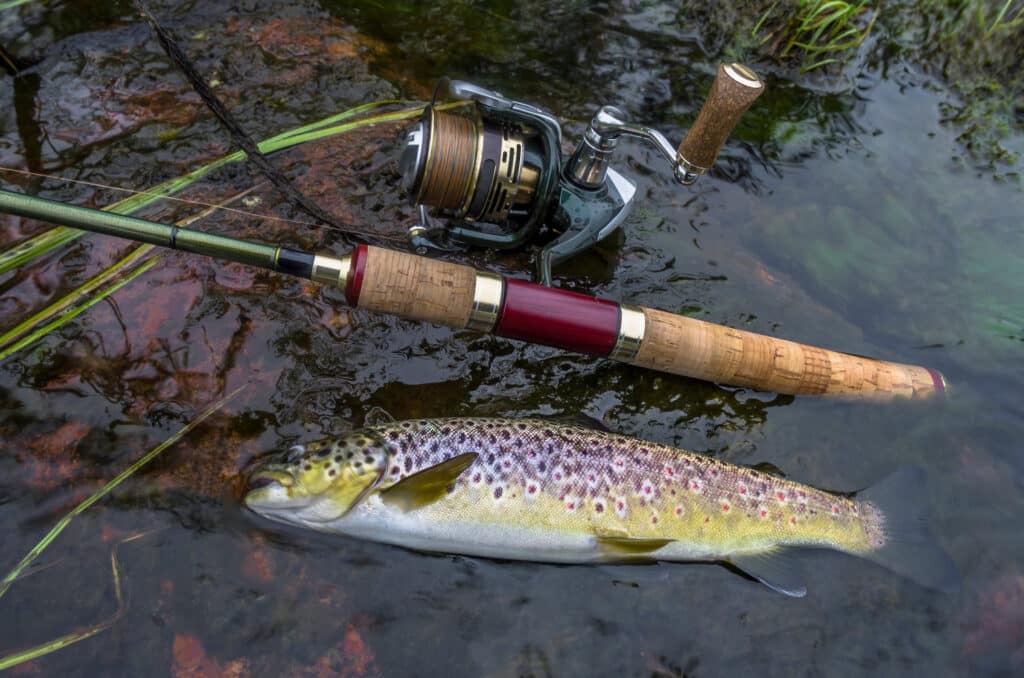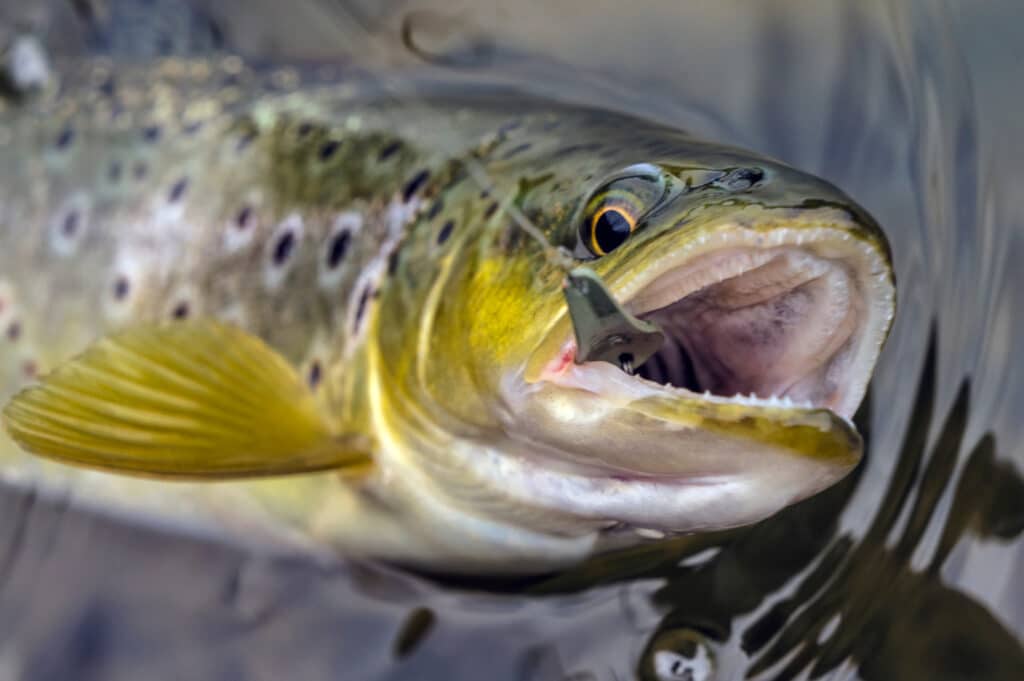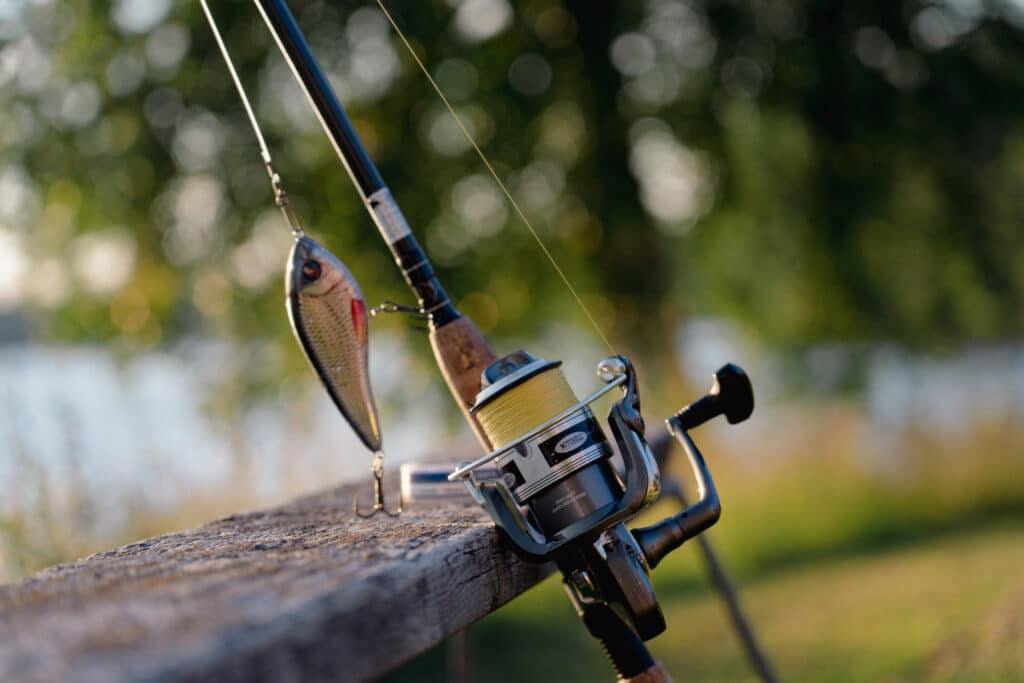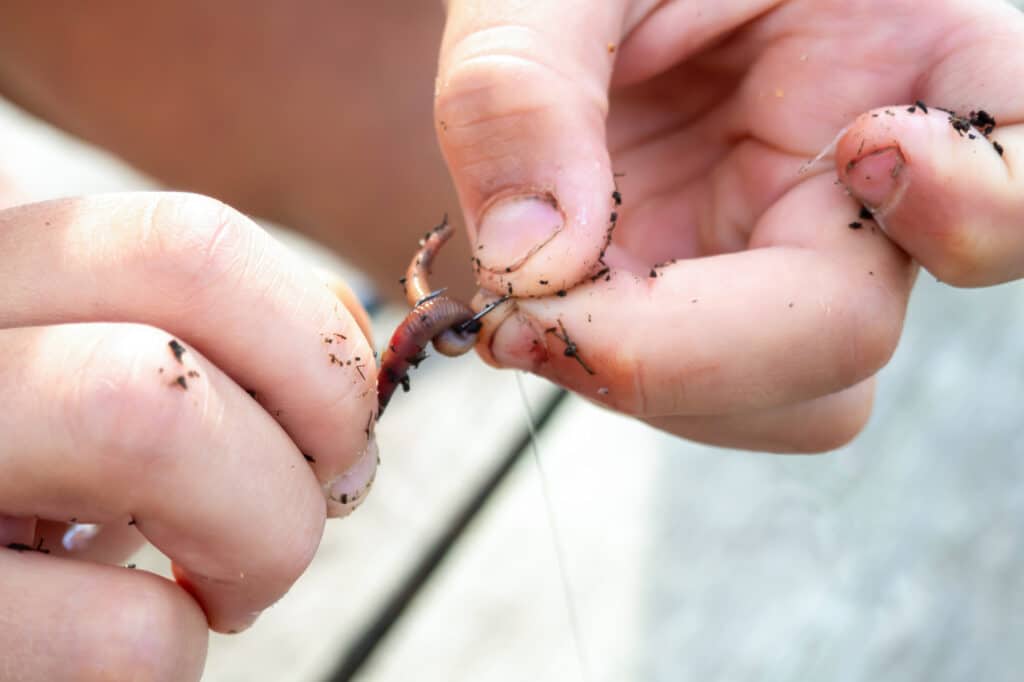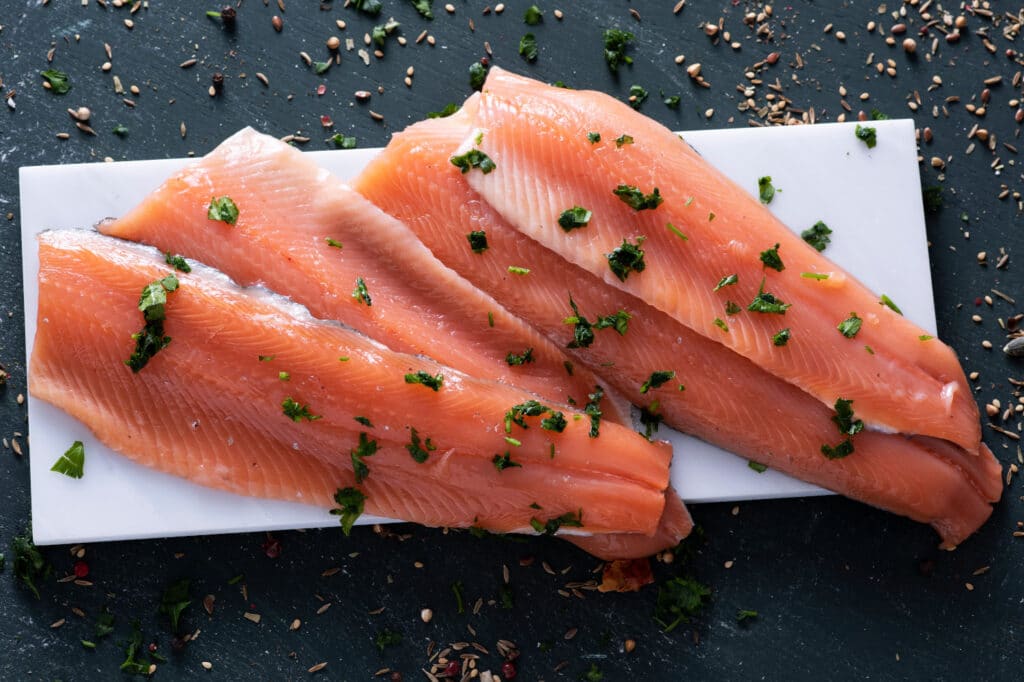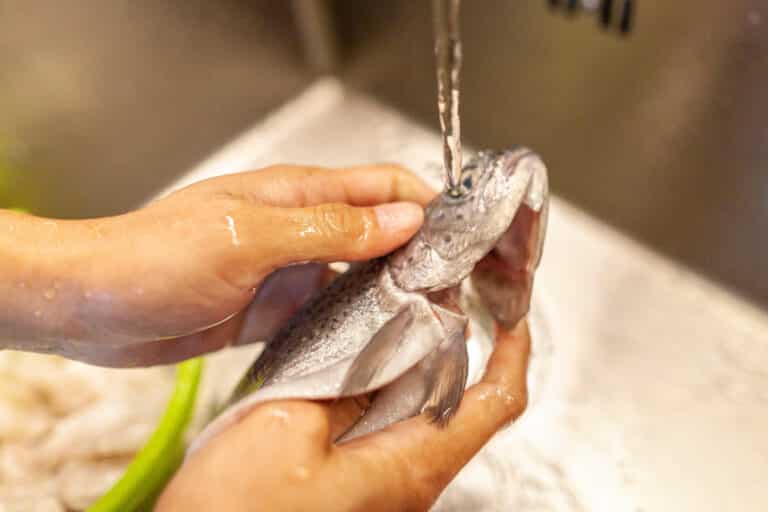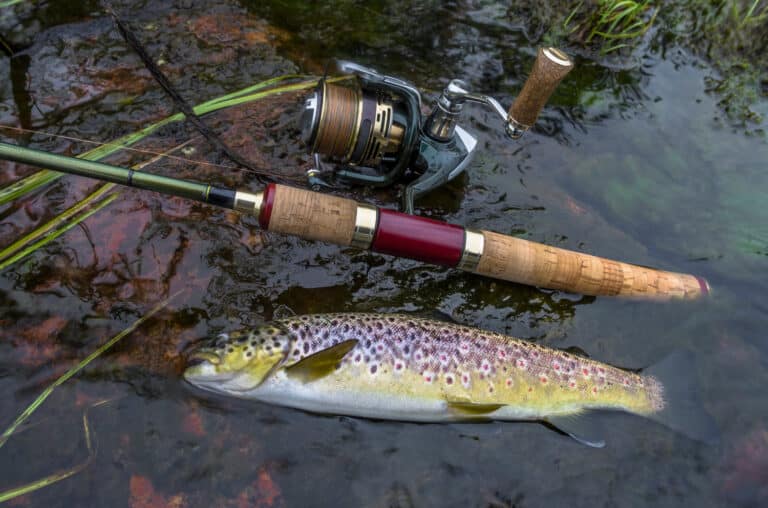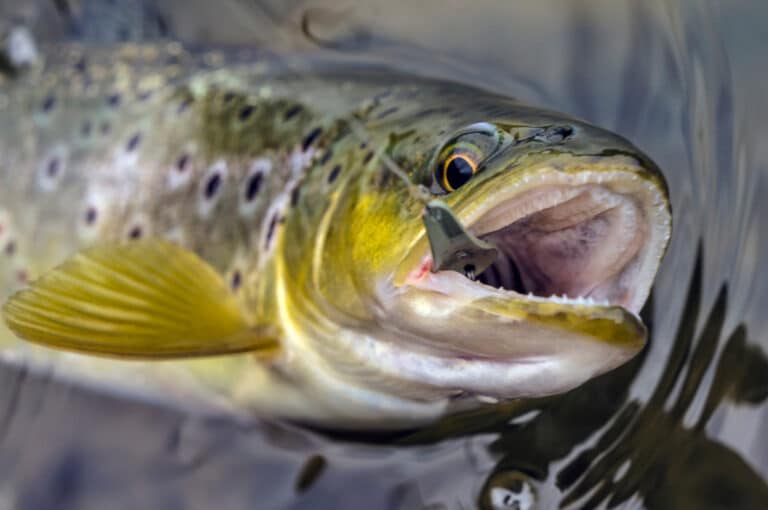Today we’re going in-depth into one of the most effective techniques in fishing: the drop shot rig.
Drop shot fishing has a little bit of a reputation for being a finicky, non-beginner-friendly technique.
But the truth is that with a little basic knowledge, anyone can do it. And most importantly, anyone can increase their fishing success by implementing it. It’s not just a technique for the pros, and even beginners should be able to catch more fish with the drop shot.
In this guide, I’ll go over the basic drop shot rig, as well as how to tie it, what weights, line, and rod to use, and the best baits and tactics for this setup. And by the time you finish reading this, you’ll have learned everything you need to go out and implement this killer presentation.
In this post, I’m starting with the basics, so if you already have the gear you need (or just want to skip to any section of this post), use the table of contents below to get the info you need.
The Wild Provides is a participant in the Amazon Affiliate program. If you click through one of the links on this site and make a purchase, we may receive a small commission at no extra cost to you. It helps to keep us up and running, but all recommendations are my own honest opinions.
What Is Drop Shot fishing?
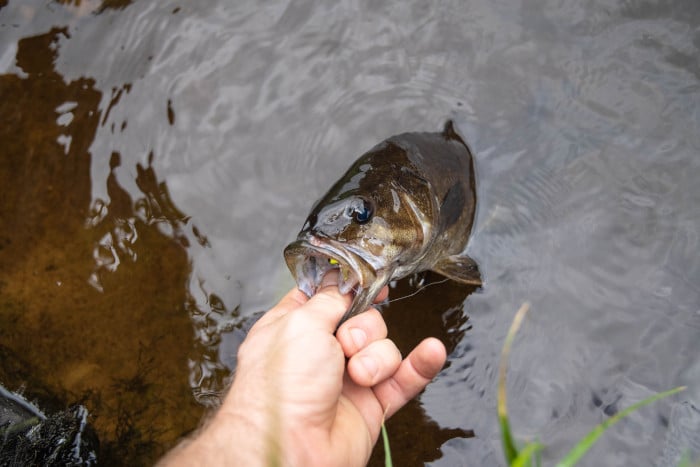
Drop shot fishing (or drop shotting) is simply one of the most effective—and versatile—presentations for bass fishing. Used correctly, it’s a finesse fishing technique that can catch fish when nothing else is working.
The basic concept is simple: you tie your bait above a sinker, letting the sinker sit on the bottom while your bait sits inline above it. That gives your bait a free-floating action that mimics the natural movements of a small baitfish, and creates a realistic presentation that a simple jighead could never accomplish.
Dropshotting can be used in just about any circumstance, but it excels when targeting non-aggressive fish. These could be springtime, cold-water bass, post-spawn summer lurkers, or even super lethargic winter-time bass. It’s the perfect go-to when the fish don’t seem to be biting.
Ultimately it’s a great skill to have in your toolbox because it’s just so versatile.
Drop Shot Fishing Gear
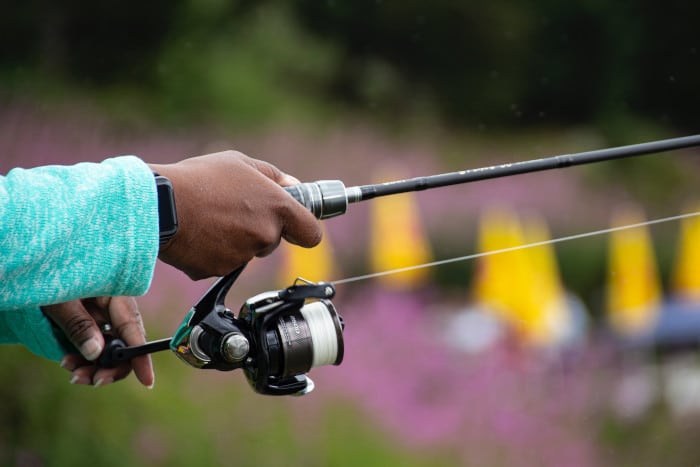
Drop shotting doesn’t have to be a gear-heavy endeavor, but there are definitely some things that will increase your chances of success.
Rod
Most light-tackle fishermen already have a rod that will work. There are a few characteristics of a rod that will help you be more effective, though. A good spinning rod should be:
- 6’6”-7’6″ in length
- Light/medium power
- Fast action tip
There are tons of rods that cover these requirements, and you don’t need an expensive one to get the job done. As you get more involved, you may want to spring for a premium rod that offers greater sensitivity, but something basic like the Ugly Stik Elite will do just fine to start (its patented tip is plenty fast for drop shotting)
Reel
Any 2000-3000 series spinning reel will work great. 1000 series reels will work fine too, but if you’re buying a new reel, 2000-3000 will provide greater versatility. I like the Okuma Ceymar series reels for the price-to-quality ratio, though there are quite a few solid options out there for under $50.
Line
The best line for drop shot fishing is similar to other light-tackle fishing applications. While line choice is largely up to preference and a lot of setups will work, I think that there is one line setup that works better than others for dropshotting.
Main Line
For your mainline, braided line in the 10-20 pound test range is the best option. There are a few good reasons for this.
The first is that braid doesn’t stretch like monofilament. This provides greater sensitivity, which is a huge benefit when trying to detect the light bites that often happen when using a drop shot.
The second is that braid has a smaller line diameter, so there is less drag in both the wind and water. Casting isn’t the most common way to fish a drop shot, but it can be very effective and braid will allow you to cast farther if necessary. This isn’t a huge deal, but more of a bonus that comes with using braid.
Using braid also allows you to use high-vis line, which I highly recommend. The best drop shot techniques (which I’ll get into below) involve keeping your line fairly loose, so a high visibility line will let you visually see even the lightest bites.
Leader
For leaders on finesse fishing rigs, I always recommend using fluorocarbon. Though it’s a little more expensive than monofilament, fluoro has several advantages that make it worth it.
Fluoro refracts less light than monofilament, so it’s nearly invisible underwater. It also has better abrasion resistance, which helps in heavy cover situations. And lastly, it doesn’t stretch near as much as mono, so it provides a better feel and sensitivity.
It depends on your preference and where you’re fishing, but fluoro in the 6-10 pound test range is usually best.
Read more on the best fluorocarbon for spinning reels here.
What’s The Best Leader Length?
Leader length depends on where and when you’ll be fishing. But the basic rule is that the shallower the water, and the less cover, the shorter the leader.
In the early season (winter/spring), bass will be holding closer to the bottom and there will be minimal vegetation. All you’ll need for a leader here is about 6-12 inches.
As the water warms and fish become more active, they’ll tend to suspend higher in the water column. There may also be grass beds that you’ll need to be above, so leaders anywhere from 18-32 inches will be best. This is also the length you’ll need if you plan on using casting presentations
Tip: Use your electronics to determine the height of grass beds in your fishing area. Then give yourself an extra 8-12 inches. (If you don’t have a fish finder, just go with the longer length).
Drop Shot Hooks
When you drop shot you’re dealing with light bites, so you’ll want a hook that provides optimal hooksets. Either circle hooks or octopus hooks in size #1 or #2 will both work great.
I regularly use octopus hooks in size #2, and Gamakatsu is your best bet. You can get packs of them from Amazon for cheap, so it doesn’t hurt to get a couple of each in both sizes.
Size 2 hooks are better for smaller baits (think 3 inches or less), and size 1 hooks are better for larger ones, like worms or 4+ inch soft plastics.
Drop Shot Weights
Getting the right weight is essential to drop shot fishing. The first, and most basic rule of thumb is to use the lightest drop shot weight you can get away with. For most shallow water situations, this will be ⅛-¼ of an ounce.
Go any deeper than about 15 feet, and you’ll want to up it to ⅜ or ½ ounce. If you’re also dealing with current, weights in this range will probably be necessary as well.
Drop shot weights also come in different shapes and types. The best weights for a drop shot rig have a crimped swivel at the top, so you don’t need an additional swivel to allow to the weight to roll and move on the bottom.
In addition to this, drop shot weights come in cylindrical and round or teardrop shapes. If you’re primarily fishing weeds, cylindrical-shaped weights will pull through easier and keep you from snagging as often. If you’re fishing the rocks then go with round weights; they’ll keep you from getting stuck in gaps and cracks.
What Is The Best Drop Shot Bait?
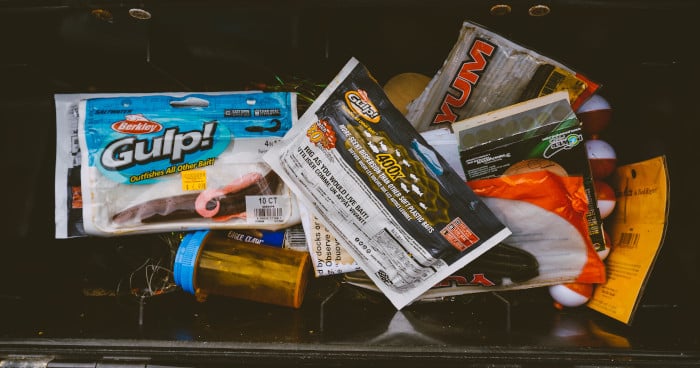
Bait selection is, as usual, where there is the most room for variation and personal preference. It’s also important to keep at least a few different options in your tackle box in case you need to change it up for conditions. That said, there are some solid choices that I recommend, and some basic qualities of drop shot baits that apply to most situations.
My favorite baits for the drop shot rig are short (3”-4.5”), straight-tail finesse worm-style soft plastics (like the OG Finesse Worm from Zoom Baits), or short soft plastic minnows. As far as colors go, it often depends on water color and clarity. Green pumpkin and watermelon are mainstay color options that regularly work great, though.
I think Berkley Gulp Minnows are the easiest for a beginner, but Keitech Easy Shiners are also great, and so are Roboworm Straight Tail soft plastics.
How To Rig A Drop Shot
Most of what I’ve said above can apply to a lot of styles of bass fishing. The rigging of a drop shot is what sets it apart, though, so here’s how to do it. The video below is a great visual description, too.
Step 1: Tie The Hook To The Mainline Using A Palomar Knot
- Feed a loop through the eye of the hook with a total line length of 12-24 inches (this will leave a long tag end to tie the sinker to; adjust this length for conditions).
- Tie an overhand knot (kept loose) so that the hook hangs from the bottom of the loop formed by the knot.
- Hold the overhand knot in place, and feed the hook through the end of the looped line, making sure it stays above the eye of the hook.
- Wet the line and tighten down the knot.
- Feed the tag end of the line down through the top of the eye of the hook.
Feeding the tag end through at the end ensures your hook will stay facing upright. This is essential for good hook sets.
Step 2: Add weight
This part is easy. Just tie a small snap swivel (using a clinch knot) to the end of the mainline.
Then clip in your desired drop shot weight. Alternatively (if you’re using dropshot-specific weights), you can tie your line directly to the sinker. This can be beneficial if you’re fishing heavy weeds, but the snap swivel allows for changing weights out easily.
Also, if you’re fishing heavy cover and snags are likely, you can tie the weight using a simple overhand knot. This ensures that when you snag, you’ll break the line at the weight and you’ll save your hook and bait.
Step 3: Rig Your Bait
There are a few ways to rig your bait on your hook. The most basic (and yet very effective) way is to hook through the nose.
If you want the easiest possible rig, just stick the point of the hook through the underside of the bait and out the top about ¼ inch from the nose. This gives the bait plenty of freedom of movement for a natural action.
Alternatively, you can insert the hook on the underside of the bait (again about ¼ inch back), then feed it up and out through the nose so the hook is just barely sticking out. This is a little more difficult to get right, but it will generally give the bait an even more natural action.
You can also wacky rig it, sticking the hook straight through the middle of the bait (which works best with long soft plastic worms, like senkos, and a wide gap hook). You’ll have to experiment to figure out if this is best for your area, but it can also work really well.
And if you’re having a tough time with weeds, you can also use the Texas rig style. Texas rigs work better with straight shank hooks, and you’ll use a longer bait (senkos work great here also) to cover the tip of the hook. This is great for preventing snags. If you want a more detailed explanation of Texas rigging, check out this video.
How To Fish A Drop Shot Rig
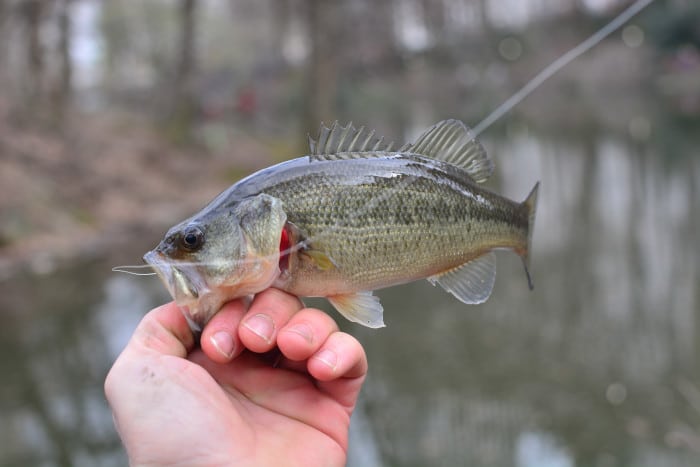
Now that you know how to rig a drop shot, you need to know how to use it. It can be effectively fished in tons of different ways, but I’ll go over the most basic here.
The drop shot is known in particular for its effectiveness in catching non-aggressive fish. When using it this way, the best method is to drop your line straight down from the boat above where you think fish are holding. Once the weight is on the bottom, reel up to just before the line would be tight. By keeping a little bit of slack in the line (but not too much), you’re allowing the bait to move freely in the water column.
With this method, you don’t want to overwork your bait. Your rod in your hand, wave action, and underwater movements will all provide plenty of action. The whole goal is for the bait to have just barely enough movement to entice a fish into an easy meal. This can be incredibly effective when they don’t seem to want to hit flashier presentations.
Tips And Tactics For Drop Shotting
In addition to the basic method, here are some more tips that will increase your hook-ups with the drop shot rig.
Tip #1: Know Your Bait
When you have a plan for catching finicky fish, you need to know that you’re executing it properly. That’s why it always helps to know what each of your baits looks like underwater, so you can tailor your technique to each style.
The easiest way to do this is to fill a tub or a bucket with water and drop your rigged baits in. In this controlled environment, you can really see how they move when worked in different ways.
Some baits require more twitching to get the action you want. Others require little to none, and others still work best in freefall. As you experiment with different baits you’ll start to learn which ones work best for each purpose, and you’ll end up catching more fish when you actually use them.
Tip #2: Mix It Up
Dropping straight down and deadsticking isn’t the only way to catch fish with drop shots. If you’ve tried it and it’s not working, don’t be afraid to experiment with other presentations.
Casting out short and letting the bait swing down below you can be a great way to give your bait action. You can also cast out and drag your sinker along the bottom of the lake, which allows the bait to swim suspended and cover more water.
Another great technique is the fall-and-lift method. Drop your sinker to the bottom, then let the bait freefall to the bottom as well. Let it rest for 10-20 seconds, then slowly lift it back up while the weight remains in place. This works best when you know you’re right on top of fish.
If you want more special techniques, check out this great article from Bassmaster. It includes tons of tips from bass fishing pros (including three-time angler of the year Aaron Martens) on exactly how to use a drop shot in different situations.
Tip #3: Don’t Overwork It
While the drop shot rig can certainly be used to catch aggressive fish too, you won’t catch the temperamental ones by overworking your bait. Keep it natural and keep it minimal.
If you’re on a boat, any wave action at all will likely do this for you. If you’re fishing from shore, you can work it a little more. Think about twitching your bait, not jerking it, and don’t do it too often. Once every 15-30 seconds or more will be plenty to get local fish interested enough without spooking them off.
Deadsticking requires patience, but it can be absolutely killer if done right.
Tip #4: Avoid Tight Lines
“Tight lines” is a great fishing phrase, but it doesn’t apply here. If your line is tight, your bait will be restricted in motion.
Leave just a little bit of slack, or bow, in your line so you know your bait can move freely. This can be the trickiest part to get right, because if you give too much slack your bait will be sitting on the bottom. But over time, you’ll start to get a feel for what your bait feels like in the water column, and this is critical to effective drop shot fishing.
FAQ
Absolutely. Try any one of the casting techniques described above for the best results. Deadsticking can work well too, especially if the bank drops off sharply from the shore.
Though drop shots are known best by anglers who target bass, you can use them for plenty of other species. Just about any panfish can be caught this way, including bluegill, crappie, and perch.
Yes! This rig can be killer for ice fishing, especially in states where you’re allowed to use more than one hook per line (just tie in extra hooks higher up the leader to cover different depths). It works particularly well for perch and walleye.
Final Thoughts
Fishing a drop shot rig doesn’t have to be difficult. While there is plenty to learn and practice, even a beginner can go out and have success with this rig. Overall it’s a great tool to have in your back pocket for when the bite is slow, and it’s a great way to catch more fish. Have fun with it!

